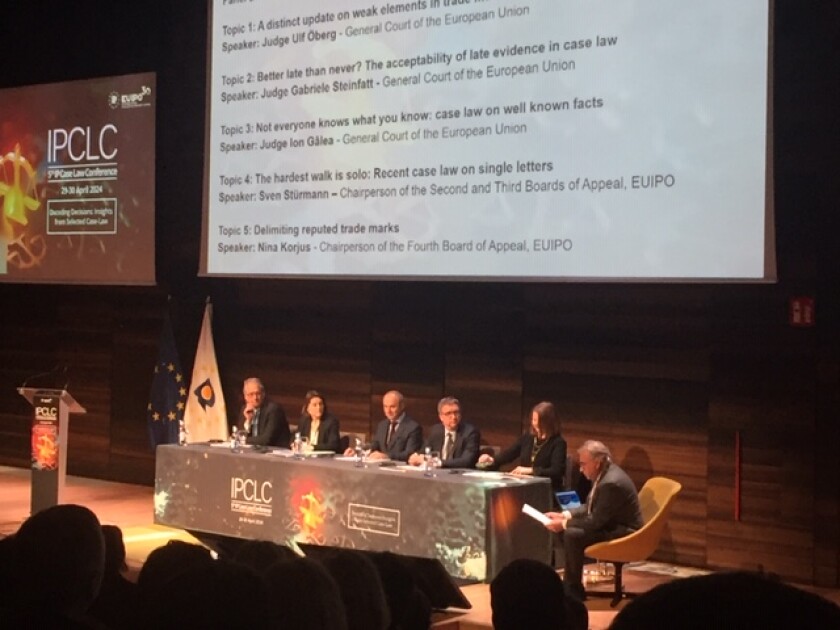A lot can change in 30 years.
This was perfectly demonstrated today, April 29, during day one of the EUIPO’s 5th IP Case Law Conference, which is being held at the EUIPO’s headquarters in Alicante.
João Negrão, executive director of the EUIPO, welcomed delegates by noting that the office is celebrating its 30th anniversary this year.
The office was established in March 1994. At the time, it was a small 10-person outfit based in downtown Alicante.
It was not until 1996 when the first EU trademark (EUTM) applications, then called Community trademarks, landed in the EUIPO’s in-tray.
Negrão noted that in the last 30 years the office has grown into an organisation boasting more than 1,000 staff.
It has taken on extra competencies along the way too, including examining and granting registered designs, which it started doing in 2003. In 2012, it began hosting the European Observatory on Infringements of IP Rights.
Most recently, it has been tasked with operating a public register of standard-essential patents as part of controversial EU plans. Talk of those proposals has been absent today, however.
“Today,” Negrão noted, “the EUIPO is one of the biggest and best IP offices in the world”.
He added, however, that there was still work to be done to improve the office’s standing and the general IP framework. Most importantly, it must engage with young people, SMEs and female designers, he said.
The office’s competencies are, of course, not the only area of change over the years.
In the first session of the day, ‘An odyssey through the evolving landscape of General Court trademark judgments’, a mix of General Court judges and representatives of the EUIPO’s Boards of Appeal (BoA) discussed shifting case law.
Judge Savvas Papasavvas, vice president of the General Court, said one of the major IP developments of the last few decades had been the Unified Patent Court coming into fruition.
However, he noted that the court is “not quite the EU-wide court we had hoped it would be”.
He added that during early discussions on case law in the EU, there were suggestions that an IP tribunal should be created within the General Court, including with “competencies for patents”.
Had that idea come to pass, some time could have been saved and a Europe-wide court with competencies to hear patent cases could have been created sooner, he joked.
Solitary confinement
The panel session then moved on to consider some more recent changes to trademark law.
One right that has become increasingly hard to protect, according to recent cases, is the single-letter trademark.
Sven Stürmann, chair of the EUIPO’s Second and Third BoAs, said these types of trademarks are “inherently weak” with a “low scope of protection”.
Special attention must be given to stylisation and the specific goods and services that the mark seeks to protect if applicants are to have a chance of success, he added.
One audience member asked if adding other elements, including colours, could make an application for a single-letter mark more registrable.
But General Court judge Ulf Öberg warned that “additional bells and whistles” were unlikely to significantly enhance the “already weak” part of an application.
Modern disclosures
In the afternoon, attention turned to designs.
Eva Maierski, partner at Lubberger Lehment in Berlin, began by explaining the law surrounding design disclosure.
According to Article 7 of the Community Design Regulation (CDR), a design shall be deemed to have been made available to the public if it has been “published following registration or otherwise, or exhibited, used in trade or otherwise disclosed”.
But, she noted, the advent of modern technologies, specifically social media, has increased the likelihood and frequency of disclosure under the CDR.
“The scope for disclosure is now probably very big,” she said.
She referenced a General Court ruling from last month (March 6) in a case involving pop singer Rihanna and sportswear brand Puma.
Puma had attempted to apply for a registered Community design (RCD) for a new shoe design.
To be legally valid, an RCD must be registered no later than 12 months after the design has been published or its disclosure has become known to “specialised circles” in the sector concerned. If this does not happen, the right to protection expires.
Puma’s design was declared invalid because Rihanna, who was then the brand’s creative director, posted a picture of herself wearing the shoes on Instagram 18 months before the application.
Maierski noted that the reliability of disclosures posted online will be considered more in the future, as will whether a social media post constitutes a disclosure becoming “known in specialist circles”.
Autumn approval
Sticking with designs, Astrid Graul, a legal and policy affairs officer at the DG Grow department at the European Commission, said the EU’s changes to its design framework were expected to be signed off in September or October this year.
The EU first announced, in 2020, it would tweak its existing design system to make it more accessible. The subsequent proposals were announced in 2022 and an agreement formally reached in December last year.
Changes included an EU-wide repair clause in the Designs Directive. The proposed clause would allow manufacturers to use protected designs to reproduce car parts for repairs where necessary to restore a vehicle’s appearance.
A backlog in work forced the formal adoption of the changes to be delayed until after the European elections in June, said Graul.
The changes, she said, would fulfil the EU’s obligation of making the bloc’s design system more accessible while not tinkering too much with something considered to be working well.
The EUIPO’s 5th IP Case Law Conference concludes tomorrow, April 30.











